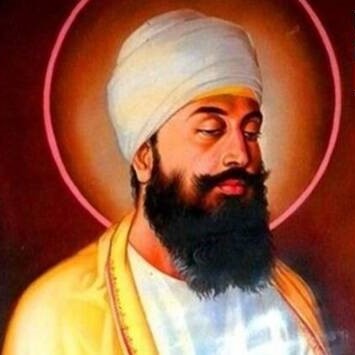Description

Disclaimer: Copyright infringement not intended.
Context: The Parkash Purab of Sri Guru Tegh Bahadur, the ninth guru of the Sikhs, was celebrated on April 11. Prime Minister Narendra Modi tweeted his tribute to Guru Tegh Bahadur.
About Guru Tegh Bahadur
Early life
- The Guru was born in Amritsar in 1621 to Mata Nanki and Guru Hargobind, the sixth Sikh guru, who raised an army against the Mughals and introduced the concept of warrior saints.
- As a boy, Tegh Bahadur was called Tyag Mal because of his ascetic nature.
- He spent his early childhood in Amritsar under the tutelage of Bhai Gurdas, who taught him Gurmukhi, Hindi, Sanskrit, and Indian religious philosophy, while Baba Budha trained him in swordsmanship, archery, and horse-riding.
- At the age of 13, Tegh Bahadur distinguished himself in a battle against a Mughal chieftain. His bravery and heroic swordsmanship in the battle earned him the name of Tegh Bahadur. (“Tegh” is ‘sword’ in Punjabi.)
- He was married to Mata Gujri at Kartarpur in 1632, and he subsequently left for Bakala near Amritsar.

Selection as the Sikh Guru
- After Guru Ram Das, the fourth Sikh guru, the guruship became hereditary.
- Guru Ram Das was succeeded by his son Guru Arjan.
- After Guru Arjan was executed by the Mughal emperor Jahangir, the Guru’s young son, Guru Hargobind, became the sixth Guru of the Sikhs.
- After Guru Hargobind’s eldest son, Baba Gurditta, died young, the guruship went to Gurditta’s 14-year-old son, Guru Har Rai, in 1644.
- Guru Har Rai remained on the seat until his death at the age of 31 in 1661.
- Guru Har Rai was succeeded by his five-year-old son, Guru Har Krishan. The eighth Guru had the shortest tenure among all the Sikh Gurus, and passed away in 1664 before he could reach the age of eight. It is said that when asked about his successor, Guru Har Krishan only said “Baba Bakala”.
- At that time, Tegh Bahadur, who was the younger brother of Baba Gurditta (and the grand uncle of Guru Har Kishan), was living in Bakala.
- He had built a ‘bhora’ (basement) in his house, where he spent most of his time in meditation.
- But since Guru Har Krishan hadn’t directly named Guru Tegh Bahadur, many claimants cropped up.
The times of Guru Tegh Bahadur
- Aurangzeb was the ruling Mughal emperor at the time.
- Guru Tegh Bahadur who started travelling extensively through Malwa and Majha, first came into conflict with the authorities when he started questioning the tradition of worshipping at the graves of pirs and faqirs.
- He preached against this practice, and urged his followers to be ‘nirbhau’ (fearless) and ‘nirvair’ (without envy).
- His sermons, delivered in a mix of Sadukhri and Braj languages, were widely understood from Sindh to Bengal.
- Guru Tegh Bahadur often alluded to Panchali (Draupadi) and Ganika in his preachings, and declared that Hindustan could regain its piety if it took refuge in one God.
- A year after setting up his headquarters in present-day Anandpur Sahib in 1665, the Guru spent four-odd years travelling up to Dhaka in the east, and going up to Puri in Odisha.
- Guru rushed back to Punjab on learning about the increasing atrocities by the Mughals.
The martyrdom
- Back in Anandpur Sahib, the Guru was approached by Kirpa Das, a Kashmiri Brahmin who sought his protection with a group from the Valley.
- Kirpa Das told Guru Tegh Bahadur that local chieftains had told him to convert or face retribution.
- The Guru assured Kirpa Das and his group of his protection and told them to tell the Mughals that they should first try to convert the Guru.
- Aurangzeb considered this an open challenge to his authority.
- Aurangzeb ordered the public execution of the Guru on November 11, 1675 after the Guru refused to embrace Islam.
- He was tortured to death and beheaded at Chandni Chowk along with his three companions.
- Some scholars have sought to introduce the Nanakshahi calendar to fix dates of important events in the Sikh history, the Guru’s martyrdom has since been observed on November 24.

Ten sikh gurus
- Guru Nanak (1469-1539)
-
- The Sikh Guru, Guru Nanak was the founder of Sikhism and was the first of the human Sikh gurus.
- He was born in 1469 in a place that is now called Nankana Sahib in Pakistan.
- He did not claim to be Hindu or Muslim, but as someone who believed in God and truth.
- He also preached to people that Hindus, Muslims and all people who believe in God are equal.
- Guru Angad (1504-1552)
-
- He created the Gurmukhi, which is the written form of the language Punjabi and taught this to many Sikhs throughout his life.
- A firm believer in education, the Sikh Guru Angad founded many schools for children and helped to improve people's ability to read and write.
- He also began the tradition of Mall Akhara - which was a form of physical and spiritual exercise.
- Guru Amar Das (1479-1574)
-
- He fought against caste prejudice.
- He wanted everyone in society to be equal and did not think it mattered if someone was rich or poor.
- He also built on Guru Nanak’s idea of the ‘free kitchen’ which was an idea that said that all followers should eat together in the same place, no matter how rich or poor they are or where they come from.
- He also introduced Anand Karaj - which was a special kind of marriage ceremony and created some new customs that meant women had more independence and equality.
- Guru Ram Das (1534-1581)
-
- He founded the city of Amritsar in northwest India, which is now the holy city for the Sikhs and also started construction of the Golden Temple.
- Guru Arjan (1563-1606)
-
- A great scholar, Guru Arjan compiled the scriptures of the Sikhs, known as the Adi Granth. He tried to teach as many people the scriptures as possible, so included it in hymns about Muslim saints too.
- He also finished the construction of the Golden Temple in Amritsar.
- They constructed it with four doors facing in four opposite directions, to show that they welcomed people into the temple from anywhere and from any background.
- Guru Arjan was ordered to be executed by the Emperor. This was because the Emperor was Muslim, and believed that Guru Arjan shouldn't include Islamic references in the Sikh holy book.
- Guru Hargobind (1595-1644)
-
- Known as the ‘soldier saint’, Guru Hargobind was the first of the Sikh gurus to teach people that sometimes it was necessary to take up arms and go to war to defend the faith.
- This was because he believed that no violence could actually encourage other evils to come about.
- He also believed that this was a way that people could protect the weak and needy, so he organised a small army.
- Guru Har Rai (1630-1661)
-
- He was a very peaceful leader.
- He devoted himself to spreading the teachings of Guru Nanak and taking on missionary work. This means that he travelled around spreading the messages of the other Sikh gurus and the Sikh faith.
- Although he was a very peaceful man, he didn't abolish the army that his grandfather - Guru Hargobind - had created. Instead, he distanced himself from it physically and never used it himself to solve conflicts with the Empire.
- Guru Har Krishan (1656-1664)
-
- Guru Har Krishan was born in 1656 and installed as a guru only five years later!
- He was the youngest of all the Sikh gurus.
- Guru Har Krishan was a humanitarian, which meant that his main aims were to help people.
- Throughout his short life, he mainly helped heal people in Delhi who were suffering from a smallpox epidemic.
- He soon contracted smallpox himself and died before he turned eight.
- Guru Tegh Bahadur (1621-1675)
-
- He believed strongly that people should be allowed and have the freedom to worship whatever religion they wanted.
- He also refused to convert to Islam and was executed and martyred as a result.
- Guru Gobind Singh (1666-1708)
-
- He was born in 1666 and was the son of Guru Tegh Bahadur.
- He introduced the Khalsa, or ‘pure ones’ and the ‘five Ks'. Just before he died in 1708, he proclaimed Guru Granth Sahib - the Sikh scripture - as the future guru.
|
PRACTICE QUESTION
Q) Discuss in brief the essence of the teachings of the ten sikh gurus and their relevance in present times. (250 words)
|

https://indianexpress.com/article/explained/explained-history/recalling-the-life-and-times-of-guru-tegh-bahadur-the-ninth-guru-of-the-sikhs-8550901/















